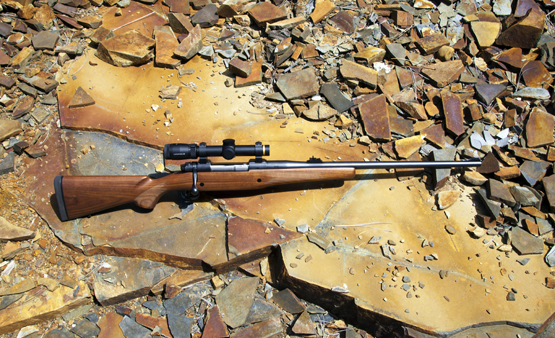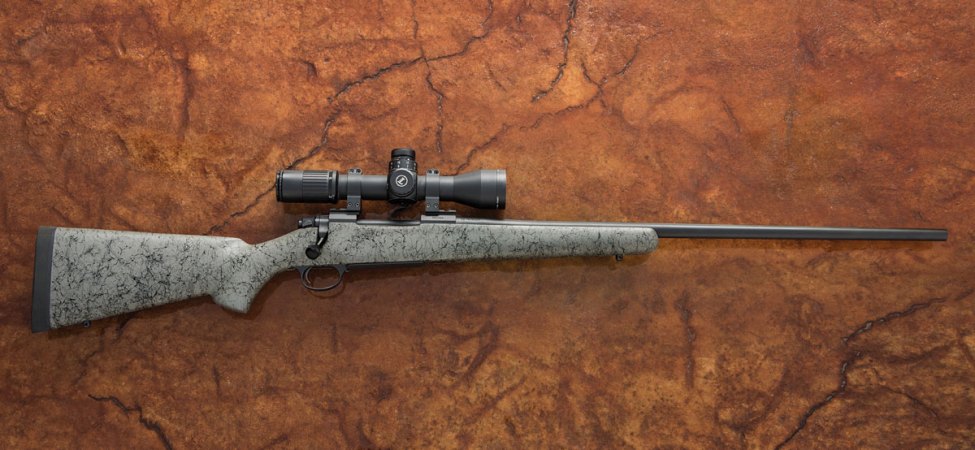We may earn revenue from the products available on this page and participate in affiliate programs. Learn More ›
Photo by Rab Cummings
What were you doing when you were 23 years old? John Browning, that industrious bugger, was designing a falling-block action for single-shot rifles. The year was 1878, and Browning and his brother were making these rifles by hand at their shop in Ogden, Utah.
A few years later, an executive from Winchester visited Browning to purchase the design. A deal was struck, and in 1885 the first firearms of the Browning-Winchester collaboration started rolling off the production line in New Haven, Conn., marking the launch of the most formidable partnership in firearms history.
The Model 1885 single-shots came in two flavors: the High Wall, which contained additional steel in the receiver for more powerful cartridges, and the Low Wall, which had less steel and an exposed hammer.
These rifles were produced in about every caliber imaginable. And because of the gun’s reputation for durability and strength, the M1885 was a go-to action when Winchester would test new cartridge designs.
Production stopped in 1920, but because shooters are such a nostalgic lot, Browning reintroduced the M1885 in 2005. It has been produced in limited quantities by Browning’s partner in Japan, Miroku, since then.
Old Action, New Cartridge
It’s fitting that with a new cartridge on the scene, the .17 Winchester Super Magnum, that Winchester would introduce it initially in an 1885.
There’s a lot to like about both the rifle and the cartridge, and I think they have the potential to make a fine pair.
Mechanically, the gun we tested was perfect. (I say “we” because the 1885 was evaluated by the panel of rifle experts that conducts Outdoor Life’s annual gun test, which will appear in the June/July issue.) Miroku, which produces many vintage Winchester models, knows how to make these older intricate actions work. All the rifle’s moving parts–trigger, falling-block action, ejector–snap crisply through their range of motion without binding or excessive wiggle. The trigger on our rifle was especially nice, breaking at just over 3 pounds.
The wood on the rifle was nice, too. The grain on the stock was straight and the forend was inletted very well, mating up with the metal on the front of the action and along the barrel in expert fashion.
The 1885 deserves better checkering, however. The simple diamond patterns on the panels of the forend and stock were executed nicely, but the borders around the panels had a clunky look to them, particularly at their points, where the mechanical cutter dug unsightly little discs into the wood. Also, the butt pad was not fit well on our rifle, though that might be because this is a pre-production sample.
These aesthetic slips aside, the M1885 casts a handsome figure. The elegant silhouette and classic touches, like the octagonal barrel, give the rifle a lot of charisma.
Sight Options
Our sample arrived with a scope on it, which we needed for accuracy testing. But we all longed to shoot the rifle with a tang sight, which is how the rifle ought to be outfitted. From the factory it will ship tapped and drilled for a scope, but it comes with a buckhorn rear sight and front brass bead.
The accuracy of the rifle was less than what we had expected, but I place the blame on the .17 WSM ammo, not the rifle, which also comes chambered for .17 HMR, .22 LR, and .22 WMR rimfire cartridges. Of the two bullet weights we had available for the .17 WSM, the 25-grain loads did significantly better than the 20-grain bullets–and this was true for both rifles I have right now in .17 WSM, the other being a Savage B-Mag. Accuracy at 100 yards with the 25-grain bullets was a bit over an inch; the results of the groups with the 20-grain load were too awful to print in a family magazine. I’m confident that in any other rimfire cartridge–and the .17 HMR in particular–the rifle would be more accurate.
But 1-inch accuracy is good enough for lots of tasks, particularly for dispatching ground squirrels, prairie dogs, and even close-in coyotes.
When you bring the 1885 to your shoulder, it is easy to feel a connection with the thousands of marksmen who have done the same thing, with the same rifle, in the years, decades, and even centuries past.
We are lucky to have such rifles, made of blued steel and walnut, readily available when so many others rolling off factory floors are cheap, plastic, and utterly forgettable.
Report Card
Overall: ***1/2
Design: A-
Performance: B+
Price/Value: B
Accuracy: Average 5-shot group at 100 yards with Winchester’s 25-grain load was 1.197 in.; the smallest group was .942 in.
Verdict: In decades past, this rifle was commonplace, but no more. It takes you back in time, off the beaten path, and beckons to be shot.
Stats
Caliber: .17 WSM
Capacity: 1
Weight: 7 lb. 8 oz. (scoped)
Trigger Pull: 3 lb. 2 oz.
Barrel Length: 24 in.
Overall Length: 40 in.
Suggested Retail: $1,470; winchesterguns.com















